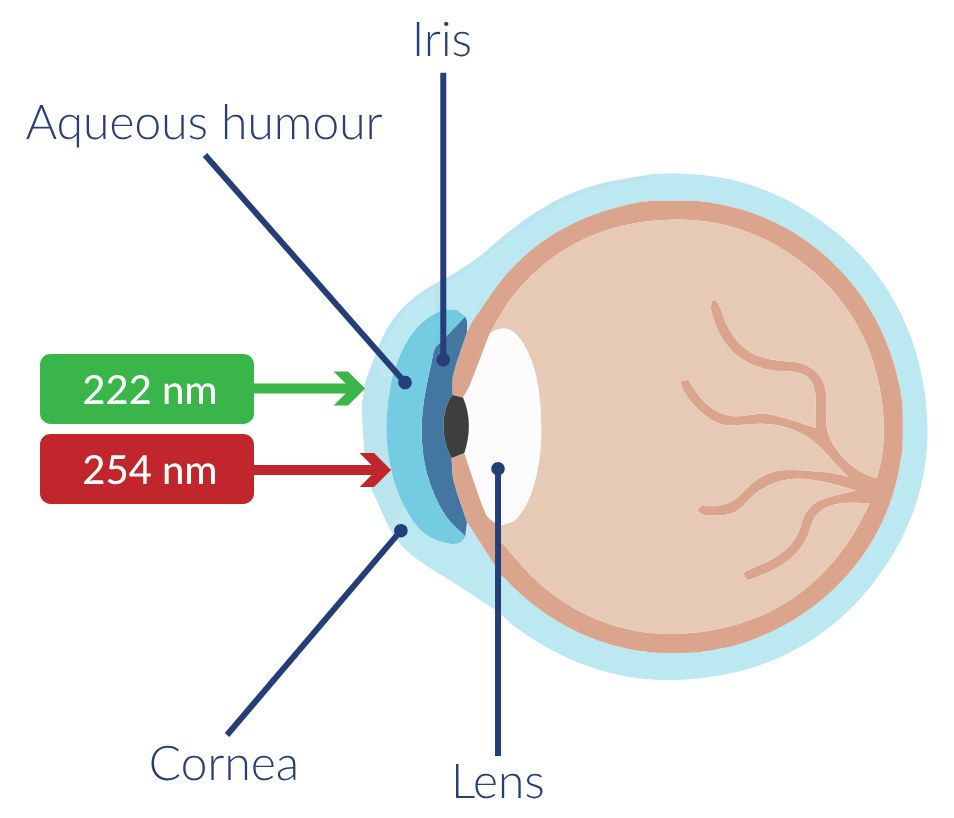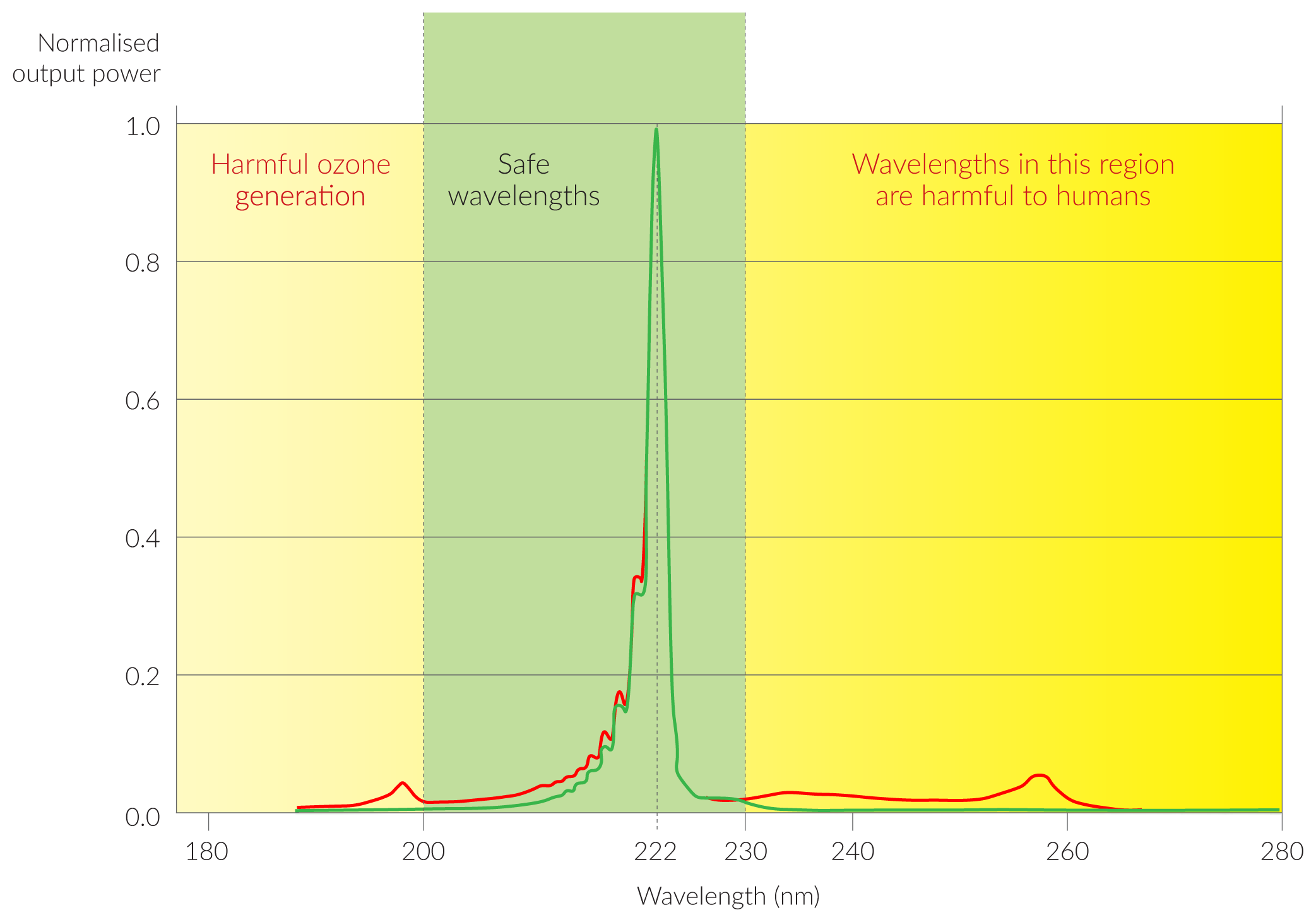Far-UVC
Learn all about the Far-UVC Technology
How it all started
UV-C Light is not a new invention. We've known about UV radiation since 1801, where it was discovered by Johann Wilhelm Ritter.
Since then the different uses of UVC Light took form an was used in cases for curing tuberculosis of the skin to disinfecting water supplies and sterilisation against microbiological contamination in kitchens, hospitalts, etc.
Also during the COVID-19 pandemic, UVC lights and Far-UVC lights were helping businesses decontaminate.
How it works
By shining Far-UVC light onto a surface, the energy from the wavelength destroys 90% of bacteria and baterial spores surface proteins to be able to penetrate the cell wall.
This damages the cells DNA/RNA, which inactives the microorganism, preventing it from replicating and infecting.
Because of the cell damage and the inability to replicate or infect, leaves the cell to die out and thereby leaving a safer area behind.
UVC Light vs Far UVC Light?
What does UVC Light do?
UVC technology is a method of using ultraviolet light to kill bacteria and viruses. Ultraviolet light is a type of electromagnetic radiation that is invisible to the human eye. UVC light has a shorter wavelength than visible light, which allows it to penetrate the cell walls of bacteria and viruses, damaging their DNA or RNA and preventing them from reproducing.
UVC technology can be used in a variety of settings, such as hospitals, schools, and homes, to decontaminate surfaces and air. UVC lamps can be installed in air ducts, or portable UVC devices can be used to decontaminate surfaces like countertops, phones, and doorknobs.
It is important to note that UVC light can be harmful to humans, so it should only be used in controlled environments where people are not present. Additionally, UVC technology is not a replacement for other cleaning methods, such as washing hands and surfaces with soap and water.
Why Far UVC?
Far UVC is a subset of the UVC spectrum with a shorter wavelength that ranges between 207 and 222 nanometers. Like UVC light, far UVC light has been shown to be effective in killing bacteria and viruses, but unlike UVC light, it does not penetrate the outermost layer of human skin or eyes.
Research has shown that far UVC light can still effectively kill viruses and bacteria in the air and on surfaces, but without the harmful effects on human skin and eyes. This makes it a potentially safer option for disinfecting public spaces and areas where people may be present, such as hospitals, schools, and public transportation.
All UV Equestrian lights are of Far UVC type and will be calibrated to your space to keep it effective and safe for you and your surroundings.
Putting an end to secondary emissions
UV Equestrian’s Far-UVC lamp consists of a tube filled with krypton chloride gas. This gas has the unique property of emitting UVC-light at 222 nm when a discharge is applied to it. When the lamp is turned on, electricity creates a discharge that excites the gas and after a short period, UV-C light at 222 nm is emitted.
A Far-UVC lamp without a filter emits light in a narrow band around a 222 nm peak, but also releases secondary emissions around 235 nm and 250 nm. These extra wavelengths are known as side-bands or side-emissions. These wavelengths harm humans, but the unique and patented safety filter in UV222 blocks them before they are emitted into the surrounding environment.
The safety filter technology in the lamp from UV Equestrian is a thin filter that only lets through light at around 222 nm and blocks all other unwanted radiation. It works much in the same way as sunglasses with UV protection, blocking the UV radiation from passing through and entering the environment, making the light from UV222 suitable for use in occupied spaces.
UV Equestrian’s Far-UVC lamp consists of a tube filled with krypton chloride gas. This gas has the unique property of emitting UVC-light at 222 nm when a discharge is applied to it. When the lamp is turned on, electricity creates a discharge that excites the gas and after a short period, UVC light at 222 nm is emitted.
A Far-UVC lamp without a filter emits light in a narrow band around a 222 nm peak, but also releases secondary emissions around 235 nm and 250 nm. These extra wavelengths are known as side-bands or side-emissions. These wavelengths harm humans, but the unique and patented safety filter in UV222 blocks them before they are emitted into the surrounding environment.
The safety filter technology in the lamp from UV Equestrian is a thin filter that only lets through light at around 222 nm and blocks all other unwanted radiation. It works much in the same way as sunglasses with UV protection, blocking the UV radiation from passing through and entering the environment, making the light from UV222 suitable for use in occupied spaces.

Do you want to learn more?
Fill out the form and we will reach out to you shortly.

